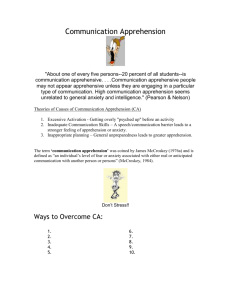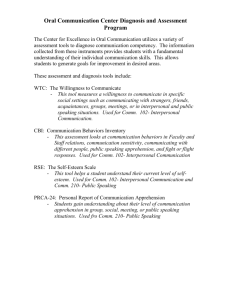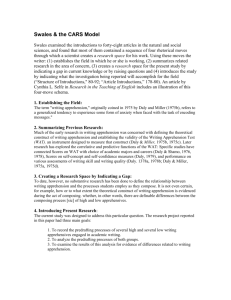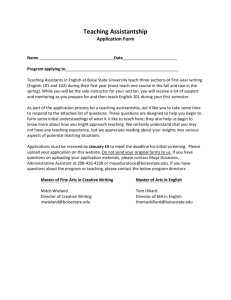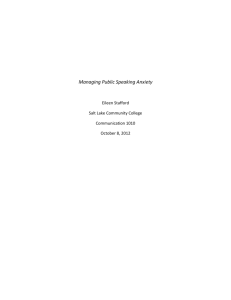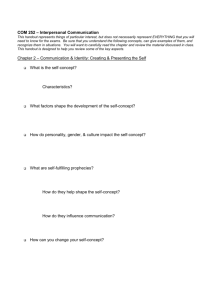factors that affects communication apprehension levels in
advertisement
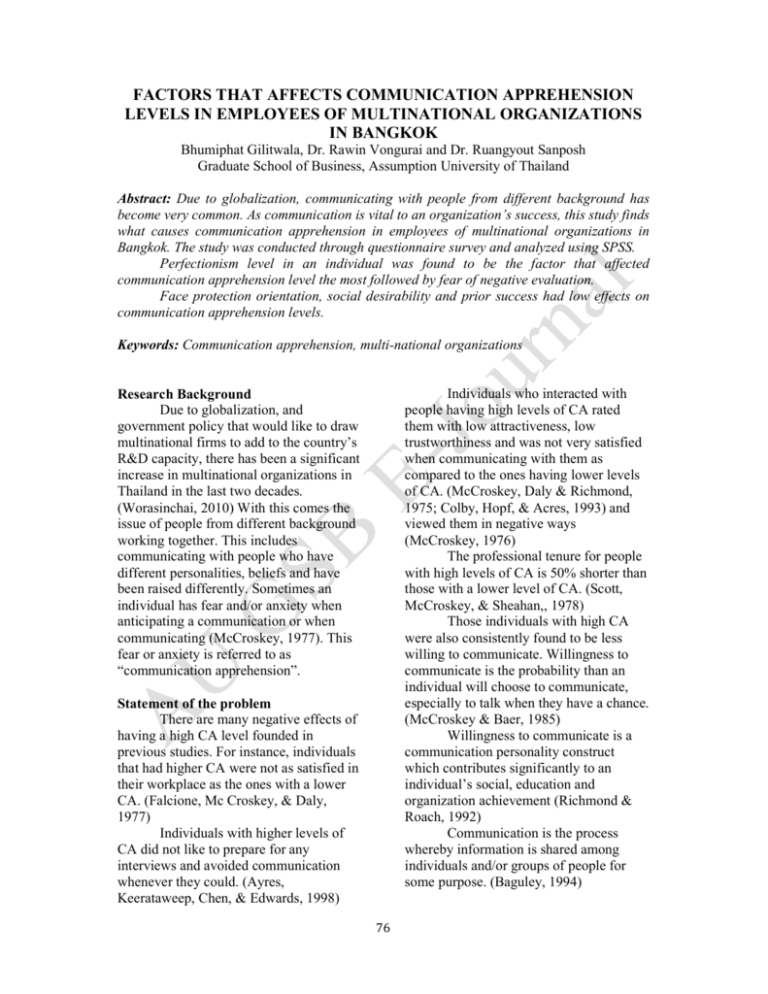
FACTORS THAT AFFECTS COMMUNICATION APPREHENSION LEVELS IN EMPLOYEES OF MULTINATIONAL ORGANIZATIONS IN BANGKOK Bhumiphat Gilitwala, Dr. Rawin Vongurai and Dr. Ruangyout Sanposh Graduate School of Business, Assumption University of Thailand Abstract: Due to globalization, communicating with people from different background has become very common. As communication is vital to an organization’s success, this study finds what causes communication apprehension in employees of multinational organizations in Bangkok. The study was conducted through questionnaire survey and analyzed using SPSS. Perfectionism level in an individual was found to be the factor that affected communication apprehension level the most followed by fear of negative evaluation. Face protection orientation, social desirability and prior success had low effects on communication apprehension levels. Keywords: Communication apprehension, multi-national organizations Individuals who interacted with people having high levels of CA rated them with low attractiveness, low trustworthiness and was not very satisfied when communicating with them as compared to the ones having lower levels of CA. (McCroskey, Daly & Richmond, 1975; Colby, Hopf, & Acres, 1993) and viewed them in negative ways (McCroskey, 1976) The professional tenure for people with high levels of CA is 50% shorter than those with a lower level of CA. (Scott, McCroskey, & Sheahan,, 1978) Those individuals with high CA were also consistently found to be less willing to communicate. Willingness to communicate is the probability than an individual will choose to communicate, especially to talk when they have a chance. (McCroskey & Baer, 1985) Willingness to communicate is a communication personality construct which contributes significantly to an individual’s social, education and organization achievement (Richmond & Roach, 1992) Communication is the process whereby information is shared among individuals and/or groups of people for some purpose. (Baguley, 1994) Research Background Due to globalization, and government policy that would like to draw multinational firms to add to the country’s R&D capacity, there has been a significant increase in multinational organizations in Thailand in the last two decades. (Worasinchai, 2010) With this comes the issue of people from different background working together. This includes communicating with people who have different personalities, beliefs and have been raised differently. Sometimes an individual has fear and/or anxiety when anticipating a communication or when communicating (McCroskey, 1977). This fear or anxiety is referred to as “communication apprehension”. Statement of the problem There are many negative effects of having a high CA level founded in previous studies. For instance, individuals that had higher CA were not as satisfied in their workplace as the ones with a lower CA. (Falcione, Mc Croskey, & Daly, 1977) Individuals with higher levels of CA did not like to prepare for any interviews and avoided communication whenever they could. (Ayres, Keerataweep, Chen, & Edwards, 1998) 76 Communication that occurs both inside and outside the organizations are known as business communication. (Boone, Kurtz & Block, 1997) Communication is not only the basis for having a good human relations, but also vital for successful business. No organization can advance without communication. The communication process is very important because it can give information, convince people, give motivation & provide common understanding (Genc, 2009) Businesses that provide more channels for both upward and downward communication were more successful (Sanchez, 1999). Communication also has a strong positive relationship with job satisfaction. (Downs, 1988). Level of communication between supervisors and subordinate also had a great impact on employee satisfaction (Clampitte & Downs, 1993). organization, therefore finding the causes of communication apprehension in an organization can help future researchers come up with the right remedy for the causes. Most previous studies have used either trait like or state like approaches to explain the cause of CA in language learning or classroom learning, but this study uses it to explain the cause of CA in a multinational organization in Bangkok. Literature Review Communication apprehension has been defined as “an individual’s level of fear or anxiety associated with either real or anticipated communication with another person or persons.” (Mc Croskey, 1977) In the 1970s to 1990s, CA was explained using the environmental based approach (Ayres, 1988; Beatty, Plax, & Kearney, 1985; Daly & Friedrich, 1981; Hsu 1998). In 1990s, it was changed from environmental based approach to a genetic-based approach by some scholars (Valencic, Beatty, Rudd, Dobos, & Heisel, 1998; Beaty, McCroskey, & Heisel, 1998). The others did not agree and came up with a combination of both biological and environmental approach (Condit, 2000). Mc Croskey, James C views this as a combination of both trait and state approaches. According to McCroskey James C., 1981, you are either born with it or you learn it. The assumption behind this approach is that once you develop a level of CA, it becomes your personality (McCroskey, 1984). It can be learned from unpleasant past experience when communicating with others (Friedrich & Gross, 1984) Trait constructs used to explain the causes of CA in previous studies Ethnic diversity Research Objectives To find the factors that cause of Communication Apprehension among employees working in multinational organizations in Bangkok. To identify which of these factors are the primary Communication Apprehension among employees working in multinational organizations in Bangkok. Scope of the Research There are two main cause of Communication Apprehension. One is situation based and the other is trait-like or characteristics of the speaker. This study focuses on the trait approach. The speakers are either born with it or they learn it from their past experiences. The attributes of the personality of speakers included in this study are, face protection orientation, Social desirability, Evaluation, Prior success and Perfectionism. Studies by Klopf &Cambra (1979) shows that CA varies in different ethnic origin. Competitiveness Significance of the Study As communication is very important as illustrated above for an 77 A study by Matsuoka, R. (2008) showed that Japanese college students who were highly competitive, possessed high levels of CA Perfectionism preferred straight talk (Adler & Elmhorst, 2002) Negative appraisal (Glaser 1981) This model assumes that if a child had been negatively reacted to their language ability, they will learn to expect negative reactions and avoid oral communication situation. One of the interviewee in a research conducted by Matsuoka,R. (2008) also confessed that she was afraid of negative evaluations. Social desirability Interviewees in studies by Matsuoka, R. (2008) expressed the desire to be perfect in different ways. Some do not want to express themselves due to lack of English resources while others wanted to maintain a good student personality and did not want other students to conclude that they cannot speak English. Wanting to be a perfectionist increased the CA levels in them. Face protecting orientation A person with high social desirability behaves in a socially and culturally acceptable manner. (Crowne and Marlowe (1964) People with high social desirability also tend to have a higher level of CA. In this the level of CA in an individual varies when faced with different situations (McCroskey James C., 1981). Most people experience this form of CA and it goes away after the situation is over (Spielberer, 1966; Lamb, 1973) State constructs used in previous studies Novelty Some interviewees in studies by Matsuoka, R. (2008) were reluctant to speak when they knew other students were better in order to maintain face. Valuing reticence According to Friedmand, ,1980, reticence is present when there is desire and ability to express but the verbalizing process is inihibited In the study by Matsuoka, R. (2008) reticence was due to Japanese Sociocultural more that the interviewees confessed caused them to be less willing to communicate orally. Prior history A new experience causes uncertainty about whether the outcome would be satisfactory (Gundykunst, 1993). A new situation causes uncertainty about how a person should behave (McCroskey James C., 1981) Formality If one has failed in the past, they are likely to fear that they might fail again. This fear of failure resulting from past experience, increases the level of CA. (McCroskey James C., 1981) Culture (high context vs. low context) In situations where high formality incurs, appropriate behaviors and phrases are predictable and known to the speaker; as a result there is no need for unique communication. (Aly and Gowing, 2001) High context cultures were found to have higher levels of CA because the nature of communication in these cultures tends to be more indirect and implicit with lots of caution and involves lesser oral communication (Gudykunst, 1983) as compared to low context culture that 78 Whereas McCroskey James C, (1981) associated formal situation with rigid behaviors and less acceptable behaviors and states that CA increases in formal situations. Familiarity with audience Aly and Gowing 2001 conducted a study in a Canadian university under the implication that if the speakers are less familiar with the audience cultural context, the speaker would possess a higher level of CA. This was not the case. McCroskey (1981) states that although not all people react to unfamiliarity in the same manner, many people do feel more relaxed when communicating with those they are familiar with and suggests an inverse relationship between the two variables. Similarity An individual tends to be more anxious when they are to be evaluated than when they are not. (McCroskey, 1981). Conceptual Framework Study by Aly and Gowing 2001 also implied that if the speaker and the audience are of different ethnic origin, the speaker is likely to possess a higher level of CA. This was not the case either. Whereas McCroskey (1981) states that in general, talking to people who are similar to oneself is more comfortable than talking to others who are different. But there is a major exception in this rule because some individuals are concerned with evaluations from their peers and they might find it more uncomfortable when talking to someone similar to them. Degree of attention Research Hypothesis H1: There is a relationship between Face protection orientation and communication apprehension H2: There is a relationship between social desirability and communication apprehension H3: There is a positive relationship between Fear of evaluation and communication apprehension H4: There is a relationship between the speaker’s prior success and communication apprehension H5: There is a relationship between perfectionism and communication apprehension Either too high or too low degree of attention from the audience causes high levels of CA due to too much concern or feels ignored respectively. Moderate level of attention from the audience is the best as it is most comfortable for most people. (McCroskey, 1981) Subordinate position This situation is common in superiorsubordinate communication where the person holding a higher position defines the appropriate behavior for the subordinate. This leaves the subordinate with less latitude for deviation and hence increases the CA level. (McCroskey, 1981) Degree of evaluation Research Methodology The research was a quantitative study using a survey data collection method. The multinational firms were identified and the questionnaires were delivered to the company. A non-probability sampling design was chosen using convenient sampling method because it is assumed that there is no difference in the employees 79 working at the different multinational organizations. Of the total 260 questionnaires distributed 250 were returned of which 222 were usable. The following are the type of organizations that responded to the questionnaire: 10.3% working in food and beverage industry 7.9% working in apparel and accessories industry 24.6% working in education industry 33.4% working in the service industry 23% working in other industry including automobile, exportimport, oil, media, advertising, IT, logistic, etc. Pearson correlation coefficient value between social desirability and communication apprehension The result of the correlation analysis was statistically significant with r=.122 which indicates a very low positive relationship among the two variables. Relationship between social desirability and each categories of communication apprehension (group, meeting, interpersonal and speech). The result of the correlation analysis were statistically significant for meeting, interpersonal and speech with r=.11, .13, .13 respectively which indicates a very low positive relationship among the variables. However, no significant relationship was found between social desirability and group. H3: There is a positive relationship between Fear of evaluation and communication apprehension. Pearson correlation coefficient value between fear of negative evaluation and communication apprehension The result of the correlation analysis was statistically significant with r=.551 which indicates a high positive relationship among the two variables. Relationship between fear of negative evaluation and each categories of communication apprehension (group, meeting, interpersonal and speech). The result of the correlation analysis were statistically significant with r=.47, .55, .48, .5 respectively which indicates a high positive relationship among the variables. For hypothesis testing Pearson Correlation analysis was used to analyze the impact of the factors that cause Communication Apprehension. Research Results H1 There is a relationship between face protection orientation and communication apprehension. Pearson correlation coefficient value between face protection orientation and communication apprehension The result of the correlation analysis was statistically significant with r=.36 which indicates a low positive relationship among the two variables. Relationship between face protection orientation and each categories of communication apprehension (group, meeting, interpersonal and speech). The result of the correlation analysis were statistically significant with r=.29, .36, .29, .36 respectively which indicates a low positive relationship among the variables. H2: There is a relationship between social desirability and communication apprehension. H4: There is a relationship between the speaker’s prior success and communication apprehension. Pearson correlation coefficient value between prior success and communication apprehension. The result of the correlation analysis was statistically significant with r= (-.16) which indicates a low negative relationship among the two variables. 80 Relationship between face protection orientation and each categories of communication apprehension (group, meeting, interpersonal and speech). The result of the correlation analysis were statistically significant with r=.29, .36, .29, .36 respectively which indicates a low negative relationship among the variables. H5: There is a relationship between perfectionism and communication apprehension (Table 24 in the appendix B) Pearson correlation coefficient value between perfectionism and communication apprehension The result of the correlation analysis was statistically significant with r=.623 which indicates a high positive relationship among the two variables. Relationship between fear of negative evaluation and each categories of communication apprehension (group, meeting, interpersonal and speech). The result of the correlation analysis were statistically significant with r=.55, .59, .58, .53 respectively which indicates a high positive relationship among the variables. Discussion This study was conducted to find what causes communication apprehension in employees working in multinational organizations in Bangkok. Five variables namely face protection orientation, social desirability, fear of negative evaluation; prior success and perfectionism were tested. Communication apprehension was also divided into 4 categories to study more details. (Group, meeting, interpersonal and speech) The main results were as follow 1. Face protection orientation The respondents’ face protection orientation was slightly high (3.36 based on 5 point likert scale). There is a low positive relationship between face protection orientation 81 and communication apprehension levels. Face protection orientation has a moderate positive relationship with meeting and speech Face protection orientation has a low positive relationship with group and interpersonal communication. 2. Social desirability The respondents’ social desirability was moderate (3.17 based on 5 point likert scale) There is a very low positive relationship between social desirability and communication apprehension. There is no significant relationship between social desirability and group discussion. 3. Fear of negative evaluation The respondents have a moderate fear of negative evaluation (3.1 based on 5 point likert scale). There is a strong positive relationship between fear of negative evaluation and communication apprehension. 4. Prior success The prior success of the respondents is quite high (3.47 based on 5 point likert scale). There is a low negative relationship between prior success and communication apprehension. 5. Perfectionism The level of perfectionism in respondents is moderate (2.75 based on 5 point likert scale). There is a strong positive relationship between perfectionism and communication apprehension. 6. Communication apprehension The level of communication apprehension in respondents is moderate (2.62 based on a 5 point likert scale) Boston, MA: McGraw-Hill Higher Education. Perfectionism has the strongest relationship with communication apprehension followed by fear of negative evaluation, face protection orientation, prior success and social desirability respectively. Although respondents scored relative high in face protection orientation, social desirability and prior success, yet it doesn’t matter much as they have low relationship with communication apprehension. Perfectionism and fear of negative evaluation have stronger relationship with communication apprehension. Respondents scored quite low on these two variables, hence explaining the low score on total communication apprehension. Limitations and directions for future research This study looks at only the trait based causes of communication apprehension because the state based is common in all and goes away after the situation. This study provides only the causes for communication apprehension. Future researches can the best ways to deal with each cause. Without knowing the cause, right remedies can’t be found. This research also has a limitation due to time limit and suggests future researchers to compare between industries (cluster study). Recommended directions for future research may include conducting a research to find what are the effects of other variables (situation based) on communication apprehension levels in organizations. Also conduct research in other organization or cluster analysis. Another useful research would be to study how to lower communication apprehension levels in perfectionists. Aly, I. and Gowing, M. (2001). Communication Apprehension: A Note About Ethnic Diversity. The Canadian Journal of Higher Education, XXXI(1), pp.209-238. Ayres, J. (1988). Antecedents of communication apprehension: A reaffirmation. Communication Research Reports, 5, 76-83. Ayres, J., Keereetaweep, T., Chen, P,E., & Edwards, P.A. (1998). Communication apprehension and employment interviews. Communication Education, 47(1), 1-17 Baguley, P. (1994). Effective Communication for Modern Business. U.K.:Mc Graw Hill Book. Beatty, M.J., Plax, T.C. & Kearney, P. (1985). Reinforcement versus modeling in the development of communication apprehension. Communication Research Reports, 2, 80-85. Beatty, M.J., McCroskey, J.C., & Heisel, A.D. (1998). Communication apprehension as temperamental expression: A communibiological paradigm. Communication Monographs, 65, 197-219. Boone, L.E., Kurtz, D.L. & Block, J.R. (1997). Contemporary Business Communication. New Jersey: PrenticeHall. Clampitt, P.G. & Downs, C. W. (1993). Employee perceptions of the relationship between communication and productivity: A field study. The Journal of Business Communication, 30, 5-28. Colby, N., Hopf, T., & Ayres J. (1993). Nice to meet you? Inter/interpersonal perceptions of communication apprehension in initial interactions. Communication Quarterly, 41(2), 221-30. Condit, C.M. (2000). Culture and biology in human communication: Toward a multicasual model. Communication Education, 49(1), 7-24. References: Adler, R., & Elmhorst, J. (2002). Communicating at work: Principles and practices for business and the professions. 82 Crowne, D. P., & Marlowe, D. (1960). A new scale of social desirability independent of psychopathology. Journal of consulting psychology, 24(4), 349-354. exploratory study. Communication Quarterly, 31, 49-55. Hsu, C. (1998). Relationships between family characteristics and communication apprehension. Communication Research Reports, 15,91-98. Klopf, D., & Cambra, R. (1979). Communication apprehension among college students in America, Australia, Japan and Korea. Journal of Psychology, 102, 27-31. Lamb, D.H. (1972). Speech anxiety: Towards a theoretical conceptualization and preliminary scale development. Speech Monographs, 39,62-67. Crowne, D.P., & Marlowe, D. (1964). The approval motive. New York: Harper & Row. Daly, J.A., & Friedrich, G. (1981). The development of Communication Apprehension: A retrospective analysis of contributory correlates. Communication Quarterly, 29, 243. Downs, C.W. (1998). Communication Audits. Glenview, IL: Scott Foresman. Leary, M. R. (1983). A brief version of the Fear of Negative Evaluation Scale. Personality and Social Psychology Bulletin, 9, 371-376. Falcione, R.L., McCroskey, J.C., & Daly, J.A. (1977). Job satisfaction as a function of employees’ communication apprehension, self-esteem, and perceptions of their immediate supervisors. Communication Yearbook, 1, 363-375. Lerwannawit, A., Serirat, S. and Pholpantin, S. (2009). Career Competencies And Career Success Of Thai Employees In Tourism And Hospitality Sector. International Business & Economics Research Journal, 8(11). Matsuoka, R. (2008). Communication apprehension among Japanese college students. Journal of Pan-Pacific Association of Applied Linguistics, 12(2), 37-48. Friedman, P.G. “Shyness and Reticence in Students.” Washington, D.C.: National Education Association, 1980. Stock No. 1675-0-00. ED 181 520. Friedrich, G., & Gross,B. (1984). Systematic desensitization. In J.A. Daly & J.C. McCroskey (Eds.), Avoiding communication: Shyness, reticence, and communication apprehension, 2nd edition (pp. 173-187). Beverly Hills, CA: Sage Publications Inc. McCroskey,.J.C., Daly, J. A., Richmond, V.P., & Cox, B. (1975). The effects of communication apprehension on interpersonal attraction. Human Communication Research, 2, 51-65. McCroskey, J.C. (1976). The problems of communication apprehension in the classroom. The Florida Speech Communication Journal, 4, 1-12. McCroskey,J.C. (1977). Oral communication apprehension: A summary of recent theory and research. Human Communication Research, 4, 78-96. McCroskey, J. C. (1981). Oral Communication Apprehension: Genc, R. (2009). Profesyonel Yoneticism Yontem ve Kavramlari, Istanbul: Seckin Yaynevi. Glaser,S.R. “Oral Communication Apprehension and Avoidance:The Current Status of Treatment Research.” Communication Education 30 (1981):32141 Gundykunst, W. (1983). Uncertainty reduction and predictability of behavior in low and high context cultures: An 83 Reconceptualization and a New Look at Measurement. Scott, M.D., McCroskey, J.C., & Sheahan, M.E. (1978). Measuring communication apprehension. The Journal of Communication, 28, 104-111. Speilberger, C.D. (1996). Anxiety and behavior. NY: Academic Press. McCroskey, J.C. (1984). The communication apprehension perspective. In J.A. Daly & J.C. McCroskey, J.C.,& Baer, J.E. (1985, November). Willingness to communicate: The construct and its measurement. Paper presented at the annual convention of the Speech Communication Associatoin, Denver, CO. McCroskey (Eds.), Avoiding communication: Shyness, reticence, and communication apprehension (pp. 13-38). Beverly Hills, CA: Sage Publications Inc. Valencic, k.M., Beatty, M.J., Rudd, J.E. Dobos, J.A., & Heisel, A.D. (1998) An empirical test of a communibiological model of trait verbal aggressive. Communication Quaterly, 46, 327-341. Worasinchai, L and Bechina, A, A, A.(2010) “The Role of Multinational Corporations (MNC’s) in Developing R&D in Thailand: the Knowledge Flow Between MNC’s and University” Electronic Journal of Knowledge Management Volume 8 Issue 1 (pp171 180), available online at www.ejkm com Richmond, V.P., & Roach, K.D. (1992). Willingness to communicate and employee success in U.S. organizations. Journal of Applied Communication Research, 20, 95115. Sanchez, P. (1999). How to craft successful employee communication in the information age. Communication World, 16, 9-15. 84
